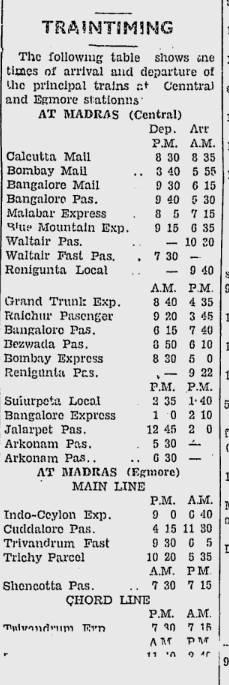|
Observe the names of the trains originating from Madras and most of the names are unheard today Image Courtesy: Indian Express Archives |
|
|
|
|
|
|
|
|
|
|
|
|
|
|
|
|
|
|
|
|
|
|
- A journey into the life of our ancestors
Indian Vintage Voices brings history to life by exploring books and newspapers over 80 years old. Through forgotten articles and timeless pictures, we reveal how people lived in India, thought, and dreamed in the past. Each post uncovers a piece of history, offering a glimpse into the world of our ancestors. Join us on this journey through time and rediscover the voices of yesterday!
Most of the news paper cuttings are from The Indian Express
|
Observe the names of the trains originating from Madras and most of the names are unheard today Image Courtesy: Indian Express Archives |
|
|
|
|
|
|
|
|
|
|
|
|
|
|
|
|
|
|
|
|
|
|
 News paper cutting from 04th March, 1935 Image Courtesy: Indian Express Archives |
|
|
|
|
|
|
|
|
|
|
|
|
|
|
|
|
|
|
|
|
|
|
|
Images Courtesy: Illustrated Weekly-1936 |
|
|
Images Courtesy: Illustrated Weekly-1936 |
Images Courtesy: Indian Express 1936 |
|
|
|
|
|
|
|
|
|
|
|
|
|
|
|
|
|
|
Original Map scanned from the book The Book A Voyage from England to India
| During the early days of cinema, movies were often released in serialized formats. Perils of the Jungle was one such production, with its first installment spanning 10 reels and the second covering 4 reels. Regal Cinema in Madras showcased this adventure-packed serial, capturing the audience’s fascination.
|
|
|
|
Image courtesy: Indian Express Archives |
Image courtesy: Indian Express Archives |
|
|
|
|
|
|
|
Image courtesy: Indian Express Archives-1936 |
|
|
|
Can you imagine modern civil engineering without steel?
Here’s an advertisement from the 1930s by Tata Iron and Steel Company, highlighting the significance of using steel in construction during that era. It marked the beginning of a new age in architecture and infrastructure, emphasizing strength, durability, and innovation in building practices.
Observe the names of the trains originating from Madras and most of the names are unheard today Image Courtesy: Indian Express A...
